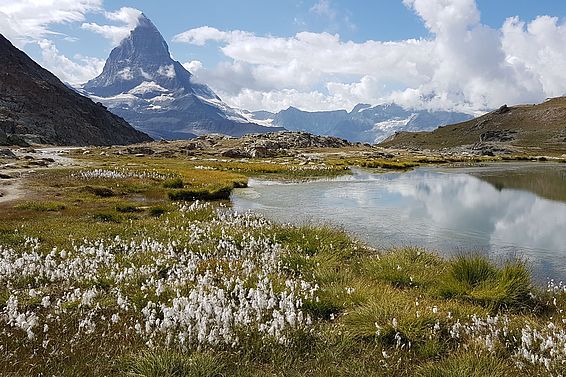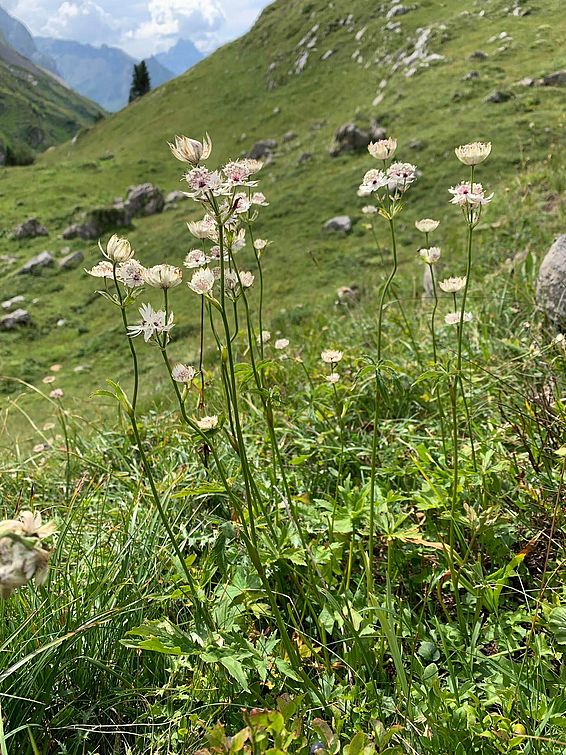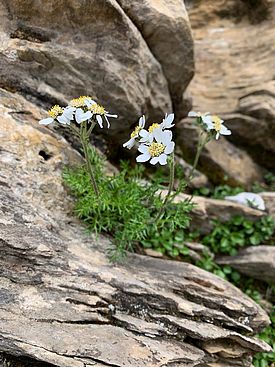22.01.2024 | Stephanie Kusma | WSL News
Climate change will alter the distribution areas of Alpine plants. The planning of protected areas must take this into account. An international study co-led by the Swiss Federal Institute for Forest, Snow and Landscape Research WSL and ETH Zürich shows where Alpine countries should establish new such areas to best preserve the region's biodiversity.
The Alps are one of the largest semi-natural areas in Europe. They are home to 4500 plant species alone - not counting mosses - and thus around a third of the entire flora of Western Europe. 400 of these plants live exclusively in the Alps. "This shows how important this mountain range is for Europe's biodiversity," says Yohann Chauvier-Mendes. Together with an international team of researchers, at the Swiss Federal Institute for Forest, Snow and Landscape Research WSL the ecologist has analysed what the mosaic of protected areas in the Alps looks like across all seven Alpine countries and where it needs to be expanded to preserve this biodiversity -now and in the future.
This is because climate change is causing plants to migrate, in most cases upwards. This means that many of them will reshuffle their ranges and therefore may move out of or into protected areas. Yet, climate change will also influence the agricultural use of the region, which in turn has an impact on the distribution of Alpine plants, e. g. when the forest overgrows abandoned pastures. Such climate change impacts could cause current protected areas to become less important in the future or new biodiversity hotspots to emerge outside of them – a process that happens without regard for national borders.
Digital maps of alpine biodiversity ¶
To find out how the biodiversity of the Alpine region will change in the future and to be able to plan the optimal distribution of protected areas, so they – even now – include more biodiversity, the researchers generated digital distribution maps of individual plant species. Firstly, under the current climate and land use, and secondly under such scenarios as they are expected in the years 2050 and 2080. "For the first time in a study of this kind, we not only looked at the number of species, but also considered how unique each one is in terms of genetic history and ecological role" explains WSL ecologist Niklaus Zimmermann, one of the lead authors of the study.
In these maps, they included existing protected areas whose conservation status corresponds to the Emerald-Natura 2000 network and categories I and II of the International Union for Conservation of Nature (IUCN) – e.g., the Swiss national park. Based on this and with the help of conservation planning simulations, they then identified areas that allow to best enhance the protection of the plant biodiversity of the Alpine region – for now and by 2050 and 2080.
Switzerland and the Mediterranean Alps most affected ¶
To this end, the researchers added to and expanded the mosaic of protected areas from 18 % to around 35 % of the Alpine area. The basis for this expansion was the 30 by 30 target agreed at the 15th United Nations Biodiversity Congress (30 % of the land cover, in this case the Alps, are under protection until 2030; see box). “In all simulations, the areas most in need of more protection were the Mediterranean and the Swiss Alps” says Chauvier-Mendes.
"Based on our simulations, Switzerland would need to establish the most new areas across the entire altitudinal gradient, as overall we have the least of them compared to our neighbours" says Chauvier-Mendes. "Only two percent of the existing transnational mosaic of strict protected areas in the Alpine region is located in Switzerland." However, there are a number of areas in the country that are protected but do not fall into the strict IUCN categories I and II. "These include for instance large hunting ban areas, forest reserves or the often smaller cantonal protection sites that are still highly valuable for biodiversity protection", says Zimmermann.
Better coordination needed ¶
In the other Alpine countries, it is mostly certain altitudes that need more protected areas, such as the mid-altitudes in Austria and the lowlands in France and Germany. In this regard the analysis highlighted another important point: "In the Alps, protection needs to be coordinated across countries in order to be optimally effective," emphasises Chauvier-Mendes, who now works at Eawag, the ETH Domain's aquatic research institute. This is currently not the case for all Alpine countries - something that should be changed, according to the researchers.
The researchers now want to expand their study: "We have only looked at where new protected areas are needed in addition to the existing ones in order to preserve biodiversity in the region in 2050 and 2080," explains Zimmermann. "We didn't look in our analyses at how best to protect the most important areas along suitable plant migration paths so that migration under a changing environment is supported. We now want to tackle this in another project."
The catchphrase "30 by 30" summarises the third of the 23 goals of the Kunming - Montreal Global Biodiversity Framework: This states that by 2030, at least 30 per cent of the Earth's land, coastal, and water areas should be protected by protected areas and other "effective area-based conservation measures". The framework was adopted by the Parties to the Convention on Biological Diversity at the 15th United Nations Biodiversity Conference in Montreal. The "30 by 30" target also emphasises, among other things, the connectivity of conservation areas and their integration into larger landscapes.
Always up to date: Subscribe to the WSL Newsletter
Contact ¶
Publication ¶
Transnational conservation to anticipate future plant shifts in Europe. Nature Ecology & Evolution, 22 January 2024 (doi: 10.1038/s41559-023-02287-3)
Copyright ¶
WSL and SLF provide image and sound material free of charge for use in the context of press contributions in connection with this media release. The transfer of this material to image, sound and/or video databases and the sale of the material by third parties are not permitted.


